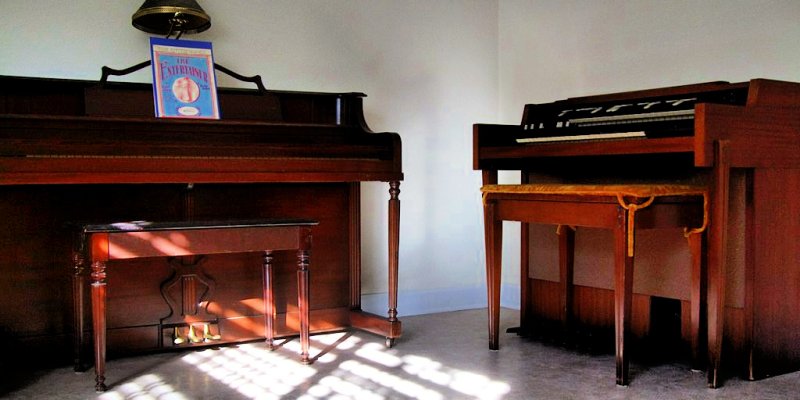
Music has the power to move our emotions, and the choice of instrument can greatly influence the mood and atmosphere of a piece.
Two of the most iconic keyboard instruments in the world, the piano and the organ, have been captivating audiences for centuries.
I want to make it clear that I have no favorite between them; they both are great instruments, and I've used both in my own original song compositions!
Despite their shared keyboard heritage, they are distinct instruments with their own histories, sounds, and challenges, so let's explore some major differences between them!
This may come as a surprise to some people, but the piano, although widely used, is not as old as the organ.
While the piano, as we know it today, emerged in the early 18th century through the ingenious craftsmanship of Bartolomeo Cristofori, the organ predates it by millennia.
Organs trace their roots back to ancient civilizations, notably appearing in Greece around the 3rd century BC.
These early versions employed air pressure to create sound and were predominantly featured in religious ceremonies, underscoring the organ's historical significance.
Related Post: Hilarious Piano Jokes For Music Nerds
The piano and organ produce sound through fundamentally distinct mechanisms. Pianos employ hammers that strike strings, resulting in a resonant and dynamic sound.
The force applied to the keys directly influences the volume and tone, granting pianists exquisite control over expression.
In contrast, the organ operates through a complex system involving pipes, air pressure, and valves. Organists manipulate a series of stops to activate specific pipes, yielding a vast array of tones and textures, from delicate to thunderous, all controlled at the player's fingertips.
One of the most noticeable disparities between these two instruments lies in their keyboards and pedals. Pianos are characterized by weighted keys that respond to touch, allowing for nuanced expression and dynamics.
Organs, in contrast, typically feature unweighted keys that offer a consistent feel across the keyboard or, in many cases, multiple keyboards.
Additionally, organs are equipped with pedalboards, allowing organists to control the bass notes and produce a profound, resonant foundation for the music.
These pedals add an extra layer of complexity and coordination, setting the organ apart from the piano in terms of technique.
Pianos are known for their capacity to produce expressive, lyrical melodies, making them a favorite for classical and romantic compositions.
Yet, their versatility extends to other genres, enabling pianists to convey intense emotions and create a broad musical palette.
Organs, on the other hand, give a majestic and grandiose sound that is often associated with religious and sacred settings.
The organ's resonant tones can inspire a sense of reverence and awe, making it an instrumental choice for church music and compositions that require solemnity and spiritual depth.
Related Post: What Instruments Did Mozart Play? Exploring His Musical Prowess
Mastery of both the piano and organ demands a high level of skill, but each instrument presents its distinct set of challenges.
Pianists must develop finger strength and dexterity to navigate the weighted keys and produce a broad dynamic range, from delicate pianissimos to powerful fortissimos.
The sensitivity of the piano responds to even the subtlest variations in touch, necessitating precise control.
Organists, conversely, face a unique set of challenges that many will agree are even more difficult to master. Coordinating hands and feet to control multiple manuals (keyboards) and the pedalboard simultaneously is a complex task.
The pedalboard adds an extra dimension, as it requires organists to control the bass notes and maintain a steady rhythm with their feet.
When considering the affordability of these instruments, pianos typically offer a broader range of options to cater to various budgets.
You can find a ton of piano models, including digital pianos that are more budget-friendly. This accessibility makes pianos attainable for aspiring musicians and enthusiasts alike. However, it's essential to note that high-end pianos can still be quite expensive.
In contrast, organs, particularly pipe organs, tend to be significantly costlier. Acquiring, installing, and maintaining a pipe organ is a substantial financial commitment.
This expense is one of the primary reasons why organs are predominantly found in churches, concert halls, and other specialized settings.
In terms of popularity, the piano enjoys a broader and more diverse appeal across various musical genres and settings.
Pianos are ubiquitous, gracing homes, schools, recording studios, and concert venues worldwide. Their versatility allows them to shine in classical, jazz, pop, rock, and many other musical contexts.
Organs, while revered in the context of church music and certain classical compositions, have a more limited presence in contemporary popular music. Its complexity and size can make it challenging to incorporate into modern genres.
Even though some contemporary songs make use of them, they are still cherished in religious settings, enhancing the worship experience with their majestic sound.
Related Post: 18 Benefits You Can Get From Playing The Piano

As a session singer, writer, and producer that has worked with over 300 clients to provide high-quality jingles, singles, and features, Yona spends her time creating and marketing new music and helpful resources for creators. Check out Yona’s latest releases on her Spotify, her Youtube and share if you like it!
If you are in need of singer, songwriter or song producer services, see what Yona Marie can offer you on her services page.